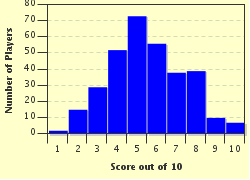Quiz Answer Key and Fun Facts
1. There is one strand of silk for every corn kernel on a cob.
2. Nintendo, the giant electronic game company, made playing cards as their first business venture.
3. Sir Richard Attenborough who played prisoner-of-war 'X' in 'The Great Escape', was actually a prisoner-of-war in Germany during WWII.
4. There are two ventricles in your heart. The left ventricle is the pump most responsible for pushing blood around your body.
True or false: The heart's ventricles are the only two ventricles in your body.
5. There are over one million tiles on the roof of the Sydney Opera House.
6. Pistachio nuts can spontaneously combust or explode.
7. William Shakespeare is buried in Westminster Abbey, London, alongside other authors such as Dickens, Chaucer and Kipling.
8. Benjamin Franklin, a Founding Father of the USA, is in the International Swimming Hall of Fame and Museum along with swimming greats such as Mark Spitz and Dawn Fraser.
9. J˙zcar, Spain, has had its walls painted blue since the Middle Ages.
10. The Statue of Liberty, from the ground to the tip of the torch, is taller than the tallest redwood trees in California.
Source: Author
Tizzabelle
This quiz was reviewed by FunTrivia editor
trident before going online.
Any errors found in FunTrivia content are routinely corrected through our feedback system.


